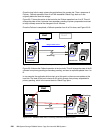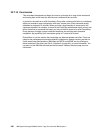298 IBM System Storage DS6000 Series: Copy Services with IBM System z
24.1 Global Mirror interfaces - overview
Global Mirror combines Global Copy and FlashCopy, which work together in an autonomic
fashion under microcode control. There are commands intended for Global Copy and
FlashCopy, as well as commands that address Global Mirror sessions. All of them can be
managed with the following interfaces:
TSO commands
DS CLI commands
ICKDSF utility commands
DS SM Web-based GUI
ANTRQST macro
Here we give an overview and examples of the use of these interfaces when managing a
Global Mirror environment. They are also covered in Part 2, “Interfaces” on page 15.
TotalStorage Productivity Center for Replication (TPC for Replication) provides management
of DS6000 series business continuance solutions, including FlashCopy, Metro Mirror, and
Global Mirror. TPC for Replication is covered in Chapter 31, “IBM TotalStorage Productivity
Center for Replication” on page 467. TPC for Replication includes functions similar to Global
Mirror Utility (GMU). GMU users should consider migrating to TPC for Replication.
24.2 Different interfaces for the same function
In this section we show how the same results can be achieved using the different interfaces.
The examples provide a first impression of the interfaces and give you an idea of their
usability and how they look and feel.
Also, with the examples, you will see that there are differences not only in the look and feel of
the different interfaces, but also in the options, parameters, and attributes used to get the
same results. For example, FlashCopy within Global Mirror needs the attributes NOCOPY,
INHIBIT TARGET WRITE, and START CHANGE RECORDING, but these particular
attributes are not explicitly available in all interfaces. For example, the TSO command to
create such a particular FlashCopy relationship for Global Mirror combines these three
attributes into a single parameter, the MODE(ASYNC) option.
The examples used here show how to establish the FlashCopy relationship between the B
and C volumes; see Figure 24-1 on page 299. Note that this is only one step out of the five or
six steps to establish a Global Mirror environment.


















